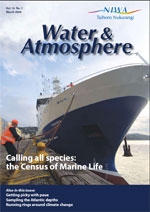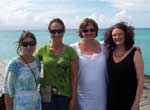PDF of this article (101 KB)



Taking responsibility for the health of water ecosystems
Pacific Island states have characteristics that make them especially vulnerable to the effects of climate change, sea-level rise, and extreme weather events. Their water resources are likely to be seriously compromised, and their coral reefs, fisheries, and other marine-based resources are all at risk.
Most tropical Pacific nations have small populations living on small islands or island groups. They face different challenges in preparing for the impacts of climate change compared to more temperate, continent-based nations, where a considerable amount of research has been focused.
Te Au o Te Moana – Across Oceania is a collaborative,multidisciplinary, whole-systems approach to governingand managing water ecosystems. An inaugural symposiumwas held in Samoa at the end of January, hosted by the RESPONSE Trust and Afeafe o Vaetoefaga. Three delegates from Te Kūwaha, NIWA’s Māori Research group, were invited to participate in the forum. They joined delegates from Australia, Fiji, Papua New Guinea, the Philippines, New Zealand, Samoa, and Tahiti.
This forum was an excellent opportunity to network and discuss the themes of responsibility, multidisciplinary knowledge, and integrated governance, and their relevance to managing aquatic ecosystems in a climate of change.
The key theme that resonated through many of the presentations was the importance of implementing community-based development projects through traditional social structures. By working at a community level, these projects are most likely to effect long-term, sustainable practices and reduce the vulnerability of Pacific Island states to climate change.
For further information, contact: Kimberley Maxwell Kelly May Dr Charlotte Severne
and see the website: www.response.org.nz/Te+Au+o+Te+Moana+-+Across+Oceania
Risks of contaminated ‘wild kai’

‘Wild kai’, gathered from the sea (kai moana), rivers (kai awa), and lakes (kai roto), is central to Māori lifestyle. A new three-year research project is investigating contaminant levels and risk to Māori health associated with wild kai. This is the first time the effects of low-level, accumulative environmental contamination (such as mercury) in wild kai have been studied. The ultimate aim of the research is to improve Māori health by identifying, quantifying, and communicating the risks associated with the collection and consumption of wild kai.
Māori from three iwi/hapū will identify species, locations, and quantities of kai moana, kai roto, and kai awa consumed. NIWA scientists will test the kai to determine the levels and types of contaminants. The research team will also trace the food chains to determine the pathways of potential contaminant uptake by tangata whenua.
Major outcomes of the research will be a generic risk-assessment framework and risk communication strategies targeted at Māori. The research will also be of interest to non-Māori and public health providers in New Zealand, as well as indigenous peoples worldwide where fish and shellfish constitute a major part of their diets.
This is a joint project between NIWA, Dr Gail Tipa (Tipa & Associates), Te Arawa, Ngāti Hokopu, and Ngai Tahu. It is funded by the New Zealand Health Research Council.
